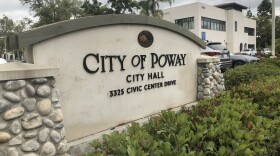When the drinking water in Flint, Mich., became contaminated with lead, causing a major public health crisis, 11-year-old Gitanjali Rao took notice.
"I had been following the Flint, Michigan, issue for about two years," the seventh-grader told ABC News. "I was appalled by the number of people affected by lead contamination in water."
She saw her parents testing the water in their own home in Lone Tree, Colo., and was unimpressed by the options, which can be slow, unreliable or both.
"I went, 'Well, this is not a reliable process and I've got to do something to change this,' " the seventh-grader told Business Insider.
Rao tells ABC that while she was doing her weekly perusal of MIT's Materials Science and Engineering website to see "if there's anything's new," she read about new technologies that could detect hazardous substances and decided to see whether they could be adapted to test for lead.
She pressed local high schools and universities to give her lab time, and then hunkered down in the "science room" — outfitted with a big white table — that she persuaded her engineer parents to create in their home.
And she set about devising a more efficient solution: a device that could identify lead compounds in water, and was portable and relatively inexpensive.
As she explains at lightning speed in her video submission for the Discovery Education 3M Young Scientist Challenge, her device consists of three parts. There's a disposable cartridge containing chemically treated carbon nanotube arrays, an Arduino-based signal processor with a Bluetooth attachment, and a smartphone app that can display the results.
Here's how it works.
The carbon nanotubes in the cartridge are sensitive to changes in the flow of electrons. Those tubes are lined with atoms that have an affinity to lead, which adds a measurable resistance to the electron flow.
When the cartridge is dipped in water that is clean, the electron flow doesn't change and the smartphone app shows that water is safe to drink. But when the cartridge is dipped in contaminated water, the lead in the water reacts to the atoms, causing resistance in the electron flow that is measured by the Arduino processor. The app then shows that the water isn't safe to drink.
Rao dubbed the device Tethys, for the Greek goddess of fresh water.
"Clean water always tastes good," she says at the end of her video. "The tool allows easy testing at home or by agencies for quick detection and remedial actions. It can be expanded in the future to test for other chemical contaminants in potable water. I hope this helps in a small way to detect and prevent long-term health effects of lead contamination for many of us."
Her solution was so ingenious that this week, Rao was named "America's Top Young Scientist" in the Discovery Education 3M Young Scientist Challenge — a distinction that comes with a giant check for $25,000.
For the past three months, Rao and nine other finalists in the competition had been paired with scientists at 3M, who helped them work from a theoretical concept to a physical prototype. Rao was matched with Kathleen Shafer, a research specialist who develops new plastics technologies.
Rao plans to save some of the prize money for college but use the rest to invest in her device to make it commercially viable.
"It's not hyperbole to say she really blew us out of the water," Brian Barnhart, a school superintendent in Illinois and one of the judges, told ABC. "The other nine kids, they were also such amazing kids, so for her to stand out the way she did with a peer group like this is like an exclamation point on top of it."
Rao says that when she grows up, she'd like to be a geneticist or epidemiologist. Her lead detection device allowed her to combine both interests, as contaminated water can cause both rashes and birth defects.
"I studied a little bit of both of these topics since I was really interested in these fields," she told Business Insider, "and then I came up with this device to help save lives."
Copyright 2017 NPR. To see more, visit http://www.npr.org/.






